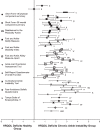Patient-Reported Outcome Measures in Individuals With Chronic Ankle Instability: A Systematic Review
- PMID: 26332028
- PMCID: PMC4641540
- DOI: 10.4085/1062-6050-50.9.01
Patient-Reported Outcome Measures in Individuals With Chronic Ankle Instability: A Systematic Review
Abstract
Context: A comprehensive systematic literature review of the health-related quality-of-life (HRQOL) differences among individuals with chronic ankle instability (CAI), ankle-sprain copers, and healthy control participants has not been conducted. It could provide a better indication of the self-reported deficits that may be present in individuals with CAI.
Objective: To systematically summarize the extent to which HRQOL deficits are present in individuals with CAI.
Data sources: We searched for articles in the electronic databases of EBSCO Host and PubMed Central using key words chronic, functional, mechanical, coper, instability, sprains, and patient-assessed. We also performed a hand search of reference lists, authors, and patient-reported outcomes (PROs) of the articles screened for inclusion.
Study selection: Studies were included if they (1) incorporated a PRO as a participant descriptor or as a study outcome to compare adults with CAI to ankle-sprain copers or healthy controls, (2) were written in English, and (3) were published in peer-reviewed journals.
Data extraction: Two authors independently assessed methodologic quality using the modified Downs and Black Index. Articles were filtered into 3 categories based on between-groups comparisons: CAI and copers, CAI and healthy control participants, copers and healthy participants. We calculated Hedges g effect sizes and 95% confidence intervals to examine PRO group differences.
Data synthesis: Of the 124 studies assessed for eligibility, 27 were included. A total of 24 articles compared PROs in individuals with CAI and healthy controls, 7 compared individuals with CAI and copers, and 4 compared copers and healthy controls. Quality scores on the modified Downs and Black Index ranged from 52.9% to 88.2%, with 8 high-, 16 moderate-, and 3 low-quality studies. Overall, we observed moderate to strong evidence that individuals with CAI displayed deficits on generic and region-specific PROs compared with copers and healthy controls. However, evidence that differences exist between copers and healthy controls was conflicting. In addition, for dimension-specific outcomes, evidence to suggest that fear of reinjury is heightened in individuals with CAI was limited.
Conclusions: The evidence suggested that CAI is associated with functional and HRQOL deficits, particularly when examined with region-specific PROs. However, PROs do not appear to differ between copers and healthy controls.
Keywords: ankle sprains; patient-centered care; region-specific outcomes.
Figures




References
-
- Fong DT, Hong Y, Chan LK, Yung PS, Chan KM. A systematic review on ankle injury and ankle sprain in sports. Sports Med. 2007;37(1):73–94. - PubMed
-
- Ferran NA, Maffulli N. Epidemiology of sprains of the lateral ankle ligament complex. Foot Ankle Clin. 2006;11(3):659–662. - PubMed
-
- Soboroff SH, Pappius EM, Komaroff AL. Benefits, risks, and costs of alternative approaches to the evaluation and treatment of severe ankle sprain. Clin Orthop Relat Res. 1984;183:160–168. - PubMed
Publication types
MeSH terms
LinkOut - more resources
Full Text Sources
Other Literature Sources
Medical
Miscellaneous

